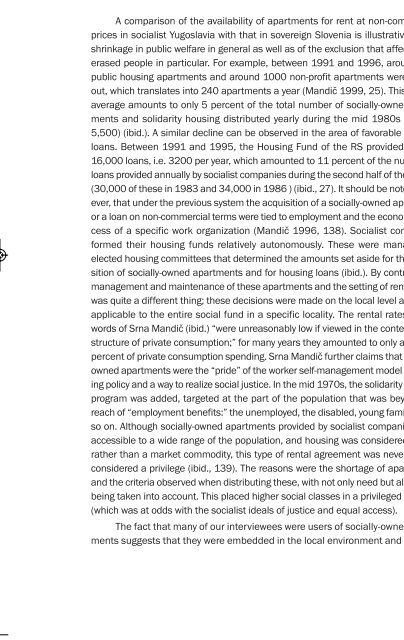The Scars of the Erasure_web
The Scars of the Erasure_web
The Scars of the Erasure_web
- No tags were found...
Create successful ePaper yourself
Turn your PDF publications into a flip-book with our unique Google optimized e-Paper software.
<strong>Erasure</strong>_4a 10.1.11 20:29 Page 3636 THE SCARS OF THE ERASUREnally, we will touch upon o<strong>the</strong>r issues involved in <strong>the</strong> erased people’s attemptsto regain <strong>the</strong>ir rights and <strong>the</strong>ir position within <strong>the</strong> legal system.5.2 HousingA comparison <strong>of</strong> <strong>the</strong> availability <strong>of</strong> apartments for rent at non-commercialprices in socialist Yugoslavia with that in sovereign Slovenia is illustrative <strong>of</strong> <strong>the</strong>shrinkage in public welfare in general as well as <strong>of</strong> <strong>the</strong> exclusion that affected <strong>the</strong>erased people in particular. For example, between 1991 and 1996, around 700public housing apartments and around 1000 non-pr<strong>of</strong>it apartments were rentedout, which translates into 240 apartments a year (Mandič 1999, 25). This annualaverage amounts to only 5 percent <strong>of</strong> <strong>the</strong> total number <strong>of</strong> socially-owned apartmentsand solidarity housing distributed yearly during <strong>the</strong> mid 1980s (around5,500) (ibid.). A similar decline can be observed in <strong>the</strong> area <strong>of</strong> favorable housingloans. Between 1991 and 1995, <strong>the</strong> Housing Fund <strong>of</strong> <strong>the</strong> RS provided around16,000 loans, i.e. 3200 per year, which amounted to 11 percent <strong>of</strong> <strong>the</strong> number <strong>of</strong>loans provided annually by socialist companies during <strong>the</strong> second half <strong>of</strong> <strong>the</strong> 1980s(30,000 <strong>of</strong> <strong>the</strong>se in 1983 and 34,000 in 1986 ) (ibid., 27). It should be noted, however,that under <strong>the</strong> previous system <strong>the</strong> acquisition <strong>of</strong> a socially-owned apartmentor a loan on non-commercial terms were tied to employment and <strong>the</strong> economic success<strong>of</strong> a specific work organization (Mandič 1996, 138). Socialist companiesformed <strong>the</strong>ir housing funds relatively autonomously. <strong>The</strong>se were ma naged byelected housing committees that determined <strong>the</strong> amounts set aside for <strong>the</strong> acquisition<strong>of</strong> socially-owned apartments and for housing loans (ibid.). By contrast, <strong>the</strong>management and maintenance <strong>of</strong> <strong>the</strong>se apartments and <strong>the</strong> setting <strong>of</strong> rental rateswas quite a different thing; <strong>the</strong>se decisions were made on <strong>the</strong> local level and wereapplicable to <strong>the</strong> entire social fund in a specific locality. <strong>The</strong> rental rates, in <strong>the</strong>words <strong>of</strong> Srna Mandič (ibid.) “were unreasonably low if viewed in <strong>the</strong> context <strong>of</strong> <strong>the</strong>structure <strong>of</strong> private consumption;” for many years <strong>the</strong>y amounted to only around 4percent <strong>of</strong> private consumption spending. Srna Mandič fur<strong>the</strong>r claims that sociallyownedapartments were <strong>the</strong> “pride” <strong>of</strong> <strong>the</strong> worker self-management model <strong>of</strong> housingpolicy and a way to realize social justice. In <strong>the</strong> mid 1970s, <strong>the</strong> solidarity housingprogram was added, targeted at <strong>the</strong> part <strong>of</strong> <strong>the</strong> population that was beyond <strong>the</strong>reach <strong>of</strong> “employment benefits:” <strong>the</strong> unemployed, <strong>the</strong> disabled, young families andso on. Although socially-owned apartments provided by socialist companies wereaccessible to a wide range <strong>of</strong> <strong>the</strong> population, and housing was considered a rightra<strong>the</strong>r than a market commodity, this type <strong>of</strong> rental agreement was never<strong>the</strong>lessconsidered a privilege (ibid., 139). <strong>The</strong> reasons were <strong>the</strong> shortage <strong>of</strong> apartmentsand <strong>the</strong> criteria observed when distributing <strong>the</strong>se, with not only need but also meritbeing taken into account. This placed higher social classes in a privileged position(which was at odds with <strong>the</strong> socialist ideals <strong>of</strong> justice and equal access).<strong>The</strong> fact that many <strong>of</strong> our interviewees were users <strong>of</strong> socially-owned apartmentssuggests that <strong>the</strong>y were embedded in <strong>the</strong> local environment and enjoyed


